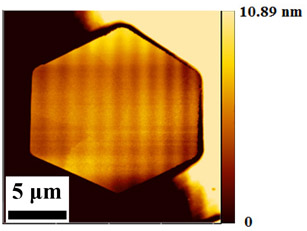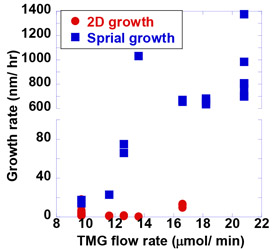Nucleus and Spiral Growth of N-face GaN (000-1)Obtained by Selective-Area Metalorganic Vapor Phase Epitaxy
Step-free surfaces without any fluctuation of thickness are promising for developing high-performance quantum devices with abrupt hetero-interfaces. We have recently succeeded in preparing a step-free Ga-face GaN (0001) surface by selective-area metalorganic vapor phase epitaxy (SA-MOVPE) [1]. An N-face GaN (000–1) surface is also attractive for obtaining high-quality InN and InxGa1–xN films because of its higher affinity to N. However, it is difficult to achieve an atomically smooth N-face GaN (000–1) surface since the surface usually contains a high density of hexagonal hillocks. In this study, we investigated the formation of a step-free N-face GaN (000–1) surface using SA-MOVPE.
GaN films were grown selectively on an N-face GaN (000–1) bulk substrate covered by SiO2 masks with a set of hexagonal openings 16 μm in diameter. Source gases were trimethylgallium (TMG) and NH3, and purified H2 was the carrier gas. The NH3 flow rate was kept at 6.7x10–2 mol/min, while the TMG flow rate was varied from 9.7 to 20.8 μmol/min.
The growth temperature was 1015oC.
Figure 1 shows an almost step-free N-face GaN (000–1) surface with few atomic steps. The surface was formed by two-dimensional (2D) nucleus growth in the absence of screw-type dislocations (STDs) within a hexagonal opening. Meanwhile, in the same sample, growth spirals with atomic steps were also observed within another hexagonal opening having STDs. Figure 2 shows nucleus and spiral growth rates of GaN plotted as a function of the TMG flow rate. The nucleus growth rates are all very low even for a higher TMG flow rate, whereas spiral growth ones increase rapidly with increasing TMG flow rate [2]. The slow growth rates in 2D nucleus growth indicate that the growth proceeds under low surface supersaturation, which results in an extremely low 2D nucleus density. The low 2D nucleus density is considered a key factor for achieving a step-free N-face GaN (000–1) surface.
This work was partly supported by KAKENHI.
- [1]
- T. Akasaka, Y. Kobayashi, and M. Kasu, Appl. Phys. Express 2 (2009) 091002.
- [2]
- C.H. Lin, T. Akasaka, and H. Yamamoto, Appl. Phys. Express 6 (2013) 035503.
 |
 |
|
|